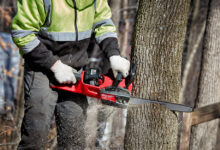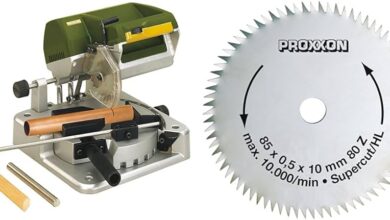**Introduction**
Chainsaws are powerful tools that require proper care and maintenance to ensure optimal performance and longevity. Proper storage is a crucial aspect of chainsaw care, as it helps protect the saw from elements, damage, and deterioration. This comprehensive guide will provide you with essential tips and techniques for effectively storing your chainsaw, helping you keep it in top working condition for years to come.
Contents
Storing Your Chainsaw: A Step-by-Step Guide
1. **Clean Your Chainsaw:** Before storing your chainsaw, thoroughly clean it to remove any dirt, debris, or sawdust that may have accumulated during use. This will prevent the buildup of corrosive substances and extend the lifespan of the saw.
2. **Sharpen the Chain:** A sharp chain is essential for efficient cutting and reduces the strain on the saw. Before storing your chainsaw, inspect the chain for any dull or damaged teeth and sharpen it as needed.
3. **Lubricate the Chain and Bar:** Proper lubrication is crucial for the smooth operation and longevity of the chain and bar. Apply chain lubricant to the chain and bar to prevent rust and minimize wear.
4. **Drain the Fuel:** Empty the fuel tank to prevent fuel evaporation, gumming up, and potential damage to the carburetor. If storing for an extended period, add fuel stabilizer to the fuel before running the chainsaw to empty the tank.
5. **Remove the Battery or Disconnect the Spark Plug:** For electric chainsaws, remove the battery. For gas-powered chainsaws, disconnect the spark plug to prevent accidental starting.
6. **Store in a Dry, Secure Location:** Choose a dry, well-ventilated area to store your chainsaw, away from moisture, extreme temperatures, and direct sunlight. Secure the saw in a stable position to prevent it from falling or being knocked over.
The Importance of Proper Chainsaw Storage
Proper chainsaw storage not only maintains the performance and lifespan of your saw but also ensures safety and prevents potential accidents. Here are some key benefits of proper storage:
1. **Prevents Corrosion:** Moisture and condensation can lead to rust and corrosion, which can damage metal components and affect the overall functioning of the saw.
2. **Protects from Extreme Temperatures:** Extreme heat or cold can warp or damage plastic components and lubricants, compromising the saw’s performance and reliability.
3. **Reduces Wear and Tear:** Proper storage minimizes wear and tear on the chain, bar, and other components, extending the lifespan of the saw.
4. **Ensures Safety:** Disconnecting the spark plug or removing the battery prevents accidental starting during storage, reducing the risk of injury.
5. **Prevents Fuel Evaporation and Gumming:** Draining the fuel and adding stabilizer prevents fuel evaporation and gumming, which can damage the carburetor and engine.
Strengths and Weaknesses of Different Chainsaw Storage Methods
Depending on your storage space and requirements, there are various chainsaw storage methods to consider, each with its own advantages and drawbacks.
1. **Wall-Mounted Storage:** Wall-mounted storage is a space-saving solution, keeping your chainsaw off the ground and easily accessible. However, it requires secure mounting and may not be suitable for all walls.
2. **Overhead Storage:** Overhead storage is ideal for those with limited floor space. However, it requires a sturdy overhead structure and can be inconvenient for frequent access.
3. **Carrying Case Storage:** Carrying cases provide protection for your chainsaw during transportation and storage. They are portable but may not offer the same level of protection as other storage methods.
4. **Chainsaw Shed:** A dedicated chainsaw shed provides the best protection from elements and extreme temperatures. However, it requires additional space and may not be a feasible option for everyone.
Table: Summary of Chainsaw Storage Methods
| Storage Method | Advantages | Disadvantages |
|—|—|—|
| Wall-Mounted Storage | Space-saving, easily accessible | Requires secure mounting, may not be suitable for all walls |
| Overhead Storage | Ideal for limited floor space | Requires sturdy overhead structure, inconvenient for frequent access |
| Carrying Case Storage | Portable, provides protection during transportation | May not offer the same level of protection as other storage methods |
| Chainsaw Shed | Best protection from elements and extreme temperatures | Requires additional space, may not be a feasible option for everyone |
FAQs: Your Questions Answered
1. **How often should I clean and lubricate my chainsaw?** Clean and lubricate your chainsaw after each use to remove dirt, debris, and prevent wear.
2. **Can I store my chainsaw outdoors?** While a chainsaw shed provides the best protection, storing your chainsaw outdoors is possible if you choose a dry, sheltered location and cover it with a tarp or protective cover.
3. **Is it necessary to remove the chain before storing the chainsaw?** Removing the chain is not necessary but can help prevent the bar from warping and reduce the overall weight during storage.
4. **How long can I store a chainsaw with fuel in the tank?** Fuel should be drained or treated with a stabilizer if storing the chainsaw for more than a month to prevent gumming and carburetor damage.
5. **What are the signs of a damaged or dull chain?** Signs of a damaged or dull chain include excessive vibration, difficulty cutting, and a lack of sawdust during operation.
6. **How do I sharpen a chainsaw chain?** Sharpening requires a specialized chainsaw sharpener or a file and jig. Follow the manufacturer’s instructions carefully to ensure correct sharpening angles.
7. **Can I store my chainsaw in a shed with other tools?** Yes, but keep it away from corrosive substances, such as batteries, fertilizers, or salt, which can damage metal components.
8. **How do I know if my chainsaw is properly stored?** A properly stored chainsaw should be clean, lubricated, and free from moisture or extreme temperatures. The chain should be sharp, and the fuel should be drained or treated with stabilizer.
9. **What are the common mistakes to avoid when storing a chainsaw?** Avoid storing the chainsaw in damp or humid locations, leaving fuel in the tank for extended periods, or skipping cleaning and lubrication before storage.
10. **How do I safely dispose of old chainsaw oil?** Dispose of used chainsaw oil at a certified hazardous waste disposal facility or recycle it according to local regulations.
11. **What is the recommended storage temperature for a chainsaw?** Ideal storage temperatures for a chainsaw range between 40°F and 70°F (4°C and 21°C).
12. **Can I use WD-40 to lubricate my chainsaw chain?** WD-40 is not recommended for lubricating chainsaw chains, as it attracts dust and dirt, which can accelerate wear.
13. **How often should I replace the chain on my chainsaw?** The frequency of chain replacement depends on usage, but generally, a chain should be replaced every 5 to 10 sharpening sessions or when it becomes excessively worn.
Conclusion
Properly storing your chainsaw is essential for maintaining its performance, longevity, and safety. By following the tips and techniques outlined in this guide, you can effectively store your saw, protect it from damage, and ensure it is ready for use whenever you need it. Remember, taking the necessary precautions and care during storage will not only extend the life of your chainsaw but also enhance its cutting efficiency and safety during operation.
**Disclaimer**
This article provides general guidelines for chainsaw storage. Always refer to the manufacturer’s instructions for specific recommendations and safety precautions related to your particular chainsaw model.









